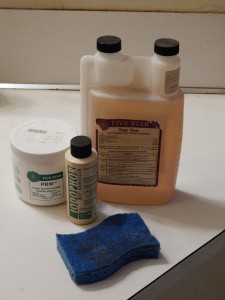 There are many ways you can improve at brewing. You can learn new ideas and try new techniques, ingredients, or equipment. You can work on perfecting the things you already do on brewday (or when formulating recipes, serving your beer, etc.). And in one case, simply changing how you think about something may lead you to being a better brewer.
There are many ways you can improve at brewing. You can learn new ideas and try new techniques, ingredients, or equipment. You can work on perfecting the things you already do on brewday (or when formulating recipes, serving your beer, etc.). And in one case, simply changing how you think about something may lead you to being a better brewer.
You’ll often hear brewers ask if their beer is infected. (I’ll skip, for now, that it is much better to refer to beer that is soured or spoiled by microorganisms as contaminated than as infected.) There is really only one answer to that question. (OK, there’s two, and one is, “no, but it’s contaminated.”) And that answer is “yes . . . to some degree.”
Every beer — commercial or homebrew — is contaminated to some degree with microorganisms. A minority of beers taste sour, or phenolic, or have other off aromas or flavors indicative of a high degree of contamination. Other symptoms of highly contaminated beers may include gushing, haziness, or a ring around the bottle neck. The majority of beers, however, do not show overt signs of contamination. Beer that tastes fresh and wholesome is still contaminated, though, just to a degree below that which causes problems.
So, all beer is contaminated. There’s no answer to the question above other than “yes, to a degree.” Looked at another way, beer doesn’t exist in two categories — contaminated (infected) and not — is exists along a continuum. At the high end of the scale, the beer is foul and undrinkable. At the low, it tastes fine and — if stored correctly — will continue to taste fine for months. It will become stale before the effects of microbial growth cause any problems. And inbetween these two ends of the spectrum are a variety of different states.
So how does recognizing this potentially make you a better brewer? I would argue it this way. If a brewer believes there is a threshold of cleanliness and sanitation below which beer is free from contamination, he or she is only going to clean and sanitize to reach that level. Further effort is going to viewed as non-productive. However, if you believe that you can always reach a higher state of cleanliness and sanitation, you will always try harder to keep your brewery clean and think of ways to improve on what you’re already doing. Obviously, there will always be a point at which you stop cleaning and start brewing, but you’ll always be aware you can be doing better.
In the near future, I’ll post some ideas on how to decrease the level of contamination in your beers. I’ll assume that you are already producing “clean” beers — beers free from any obvious signs of gross contamination — and discuss the possible benefits to improving your cleaning and sanitation program when it is already “good enough.”
—
Related Articles
Can You Cut Corners? (Cleaning and Sanitation)

Speak Your Mind